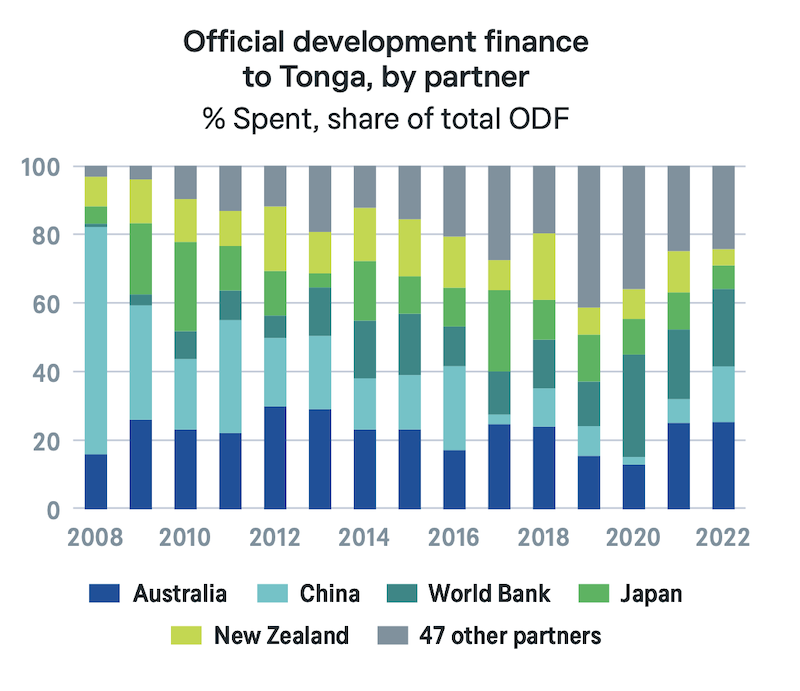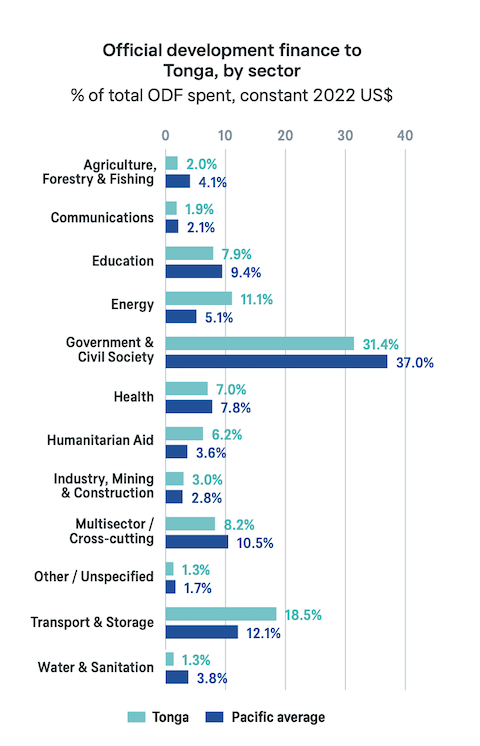
Tonga remains among the most aid-reliant countries in the world, ranking second among 127 developing countries with aid accounting for 55% of national income, says a new report published by Australia's Lowy Institute today. It reports a recent sharp decline in overseas development finance to the Pacific islands and forecasts that aid from major bilateral donors will flatline in coming years in the region.
The Lowy Institute’s new 2024 Pacific Aid Map and Key Findings Report is the seventh edition of their annual assessment of development and aid flows to the Pacific Islands region and tracks all donors’ commitments and disbursements to the region from 2008 to 2022.
It concludes that the outlook for development support in the Pacific is uncertain - trending a sharp decline in overall aid flows in the Pacific and a growing donor reliance on loans over grants.
“Forecasting of major bilateral donor aid budgets indicates ODA — which includes grants and concessional loans and accounts for around 85% of the Pacific ODF package — will flatline in coming years. Pressures on both donor and Pacific government budgets are likely to grow, meaning more will need to be done with less to secure critical development wins.
“The allocation of development budgets from the region’s major donors also appears increasingly shaped by geopolitical concerns, raising questions about the trade-offs and sustainability of the current course.
“On the whole, and despite a three-year pandemic-induced ODF surge, development support in the Pacific has become increasingly inadequate, caught between elevated regional needs, economic fragility, and heightened geopolitical pressures,” it says.
The report details key trends and development challenges for countries in the region over the period 2008-2022.
Tonga
In Tonga during this period, $2 billion was spent and $2 billion committed over some 2,236 projects.
With a GDP of $492 million, Tonga is the sixth-largest economy in the Pacific, and accounts for 1.4% of regional GDP. Tonga has a population of 106,000 (2022), resulting in a GDP per capita of $4,400, ranking eighth in the Pacific.
Tonga has the second-highest Official Development Assistance (ODA) to Gross National Income (GNI) ratio in the Pacific Islands region
“The Tongan government’s development agenda is focused on the continued recovery from the Covid- 19 pandemic and the Hunga-Tonga Hunga-Ha‘apai volcanic eruption and tsunami event. Health sector reform and disaster resilience are also key priorities. At 0.739, Tonga’s Human Development Index score ranks 98th out of 193 ranked countries.”
“Between 2008 and 2022, annual Official Development Finance (ODF) disbursements to Tonga — including grants, loans, and other forms of assistance — averaged $125 million. As a share of Tonga’s total received development support, loans have declined significantly over the past decade. Between 2008 and 2011, loans made up 23% of total financing to the country.
Between 2019 and 2021, the loan share dropped to just 4%. The bulk of this lending came from China to fund a rebuild of the Nuku‘alofa business district and a national roads project.
The International Monetary Fund ranks Tonga’s risk of debt distress as high, in large part a product of the repayment deadline on Chinese loans.”
Close to nine-tenths of ODF support to Tonga comes from six development partners, led by Australia (22%), China (19%), the World Bank (14%), Japan (13%), New Zealand (12%), and the Asian Development Bank (9%).

--
Explore the 2024 Pacific Aid Map
This interactive database tracks and maps aid and development finance flows from the international community to the Pacific Islands region. The research covers Cook Islands, Fiji, Kiribati, Marshall Islands, Federated States of Micronesia, Nauru, Niue, Palau, Papua New Guinea, Samoa, Solomon Islands, Tonga, Tuvalu, and Vanuatu, with complete data from 2008 to 2022.



